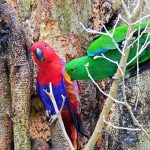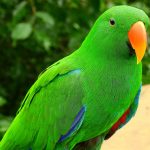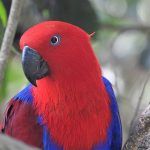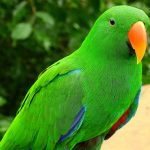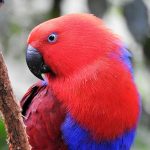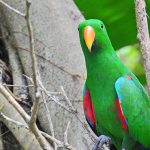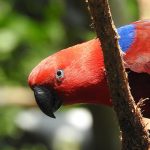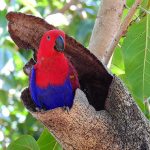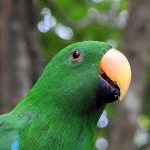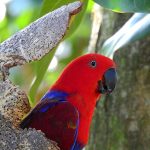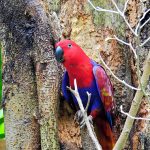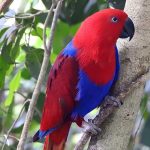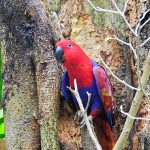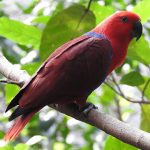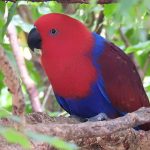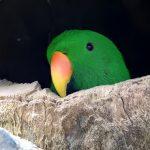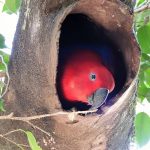ECLECTUS PARROT
Eclectus roratus
A Jewel of Northern Australia’s Canopies
Hidden among the leafy crowns of rainforests and woodlands across far northern Queensland and the Cape York Peninsula, the Eclectus Parrot stands as a vibrant symbol of Australia’s tropical north. Their remarkable beauty, distinct behaviours, and the pronounced differences between male and female plumage make the Eclectus Parrot both a scientific marvel and a conservation priority.
Distribution and Habitat
The Eclectus Parrot is native to the northernmost regions of Australia, with populations primarily found:
- Across the dense rainforests of Cape York Peninsula
- Along the coastal forests and fringes of the Torres Strait
- Within select patches of savannah woodland
Their habitat preference centres on areas rich with old-growth trees, whose hollows provide vital nesting sites. The vibrant sounds of the Eclectus Parrot echo through the humid, green world of these tropical canopies, painting an audible tapestry against the soft chorus of wind and insects.
Striking Sexual Dimorphism
Perhaps the most arresting feature of the Eclectus Parrot is its extreme sexual dimorphism – where males and females are so visually different they were once thought to be separate species. This phenomenon is rare among parrots and even more so at such an intense level across the animal kingdom.
| Gender | Plumage and Features | Beak Colour | Wing Accents |
|---|---|---|---|
| Male | Bright emerald green | Vivid orange/red | Blue to purple undertones |
| Female | Deep red or maroon | Black | Brilliant purple on chest, blue on tail |
- Males possess glossy, leaf-green feathers with blue or purple marks under their wings and a luminous red upper beak – blending harmoniously into green forest foliage.
- Females are adorned in a regal red or maroon, with a patch of violet-blue across the chest and a contrasting black beak. Their colours stand out dramatically, especially at dawn and dusk when the forest is awash with slanting golden light.
Evolutionary Significance
This sharp sexual dimorphism is believed to offer survival advantages. Males rely on camouflage to avoid predators as they forage, while the females’ bold appearance may signal territory occupation and attract mates, particularly around the nesting site.
Feeding Ecology and Dietary Specialisation
The Eclectus Parrot is an arboreal forager, moving with agility among branches in search of a diverse and seasonally shifting diet:
- Fruits: A primary staple, including figs, native plums, and wild mangoes
- Seeds and Nuts: Sourced from rainforest trees, requiring strong beaks to open
- Blossoms and Nectar: Providing essential nutrients and hydration
- Berries and Leafy Greens: Supplementing with vitamins and minerals
Their dietary selectivity is extraordinary. Eclectus Parrots seek out foods rich in specific nutrients, sometimes bypassing more abundant food if it does not meet their physiological needs. This behaviour underscores the complex ecological relationships that tie the species to the health and diversity of their rainforest homes.
Breeding and Family Life
Eclectus Parrots are cavity nesters, relying on mature, often centuries-old trees for nesting hollows. Their breeding journey includes:
- Nest Selection: Females identify suitable hollows high above ground, where the canopy filters golden light, and cool damp air rises from the forest below.
- Nest Preparation: The female prepares the cavity, lining it with leaves, bark, and other soft materials to cushion the eggs.
- Egg Laying: Typically, 2 to 3 eggs are laid per clutch.
- Incubation: Both parents share incubation responsibilities for roughly 26–28 days.
- Raising Chicks: After hatching, the chicks are nourished by both parents. Out of the nest, the young embrace the dappled world of the treetops in 10–12 weeks.
Throughout this process, the female often remains in the nest for extended periods, receiving food from the male, who travels long distances in search of provisions.
Communication and Behaviour
Despite their dazzling appearance, Eclectus Parrots are relatively quiet compared to many other parrot species. Their vocal repertoire includes:
- Males: High-pitched, melodic whistles and soft chirps – often heard as they forage or communicate with family members.
- Females: Lower, more guttural grunts and squawks, especially during nesting, serving both as warning calls and signals to their mates.
Through these understated sounds, they maintain intricate social bonds and navigate the complex, shadowy world of the rainforest.
Conservation Status and Challenges
The Eclectus Parrot is currently classified as Vulnerable within Australia. They face formidable threats:
- Habitat Loss: Large-scale deforestation and land clearing reduce the number of viable nesting hollows and foraging sites.
- Pet Trade: Capture for the pet trade adds additional pressure on wild populations, disrupting local breeding success and population stability.
- Environmental Changes: Shifts in climate and fire regimes further threaten their delicate rainforest ecosystems.
Conservation efforts centre on:
- Habitat Protection: Safeguarding remaining rainforests and promoting the regeneration of degraded habitats.
- Sustainable Forestry: Encouraging logging practices that preserve old-growth trees vital for nesting.
- Public Awareness and Research: Increasing understanding of the species’ needs and advocating for responsible pet ownership to reduce illegal collection from the wild.
The Significance of the Eclectus Parrot
Beyond their beauty, Eclectus Parrots play a subtle yet essential role in the health of Australia’s tropical forests. Their selective foraging helps disperse seeds and pollens, contributing to the regeneration and diversity of rainforest flora.
Their captivating presence serves as a living reminder of the interconnectedness of Australia’s natural environment – demonstrating just how crucial every element, from the tallest tree to the most secretive nest, is to the survival of unique and ancient ecosystems.
The Eclectus Parrot offers an enchanting window into the intricate world of Australia’s rainforest wildlife. Their dramatic sexual dimorphism, captivating behaviours, and delicate place within the northern forests highlight both the wonders and vulnerabilities of Australia’s natural heritage. As stewards of this remarkable biodiversity, our ongoing efforts to protect rainforests and understand these unique birds offer hope not just for the Eclectus Parrot, but for the vibrant web of life that surrounds them.
By deepening our connection to species like the Eclectus Parrot, we can help inspire conservation action and ensure these living jewels continue to thrive for generations to come.

